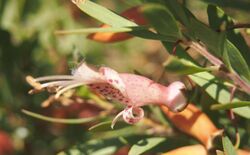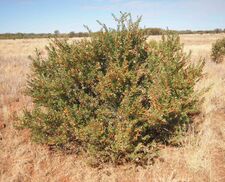Biology:Eremophila maculata
| Spotted emu bush | |
|---|---|

| |
| Eremophila maculata subsp. maculata leaves and flowers | |
| Scientific classification | |
| Kingdom: | Plantae |
| Clade: | Tracheophytes |
| Clade: | Angiosperms |
| Clade: | Eudicots |
| Clade: | Asterids |
| Order: | Lamiales |
| Family: | Scrophulariaceae |
| Genus: | Eremophila |
| Species: | E. maculata
|
| Binomial name | |
| Eremophila maculata | |
Eremophila maculata, also known as spotted emu bush[2] or spotted fuchsia-bush,[3] is a plant in the figwort family Scrophulariaceae, and is endemic to Australia . It is the most widespread of its genus in nature and probably the most frequently cultivated Eremophila. It is a spreading, often densely branched shrub with variable leaf shape and flower colour, but the other features of the flowers such as the size and shape of the parts are consistent. The inside of the flower is often, but not always, spotted.
Description
Eremophila maculata is a low spreading shrub, which usually grows to less than 2.5 metres (8 ft) tall. Its leaves range in size from 3.8 millimetres (0.1 in) to 45 millimetres (2 in) long and 0.5–18 millimetres (0.02–0.7 in) wide, and range from almost thread-like to almost circular but are nearly always glabrous and always lack teeth or serrations on the edges.[2][3][4]
The flower colour often varies even within a single population and may be pink, mauve, red, orange or yellow, often spotted on the inside. Flowers occur singly in the leaf axils and have a glabrous, S-shaped stalk, 10–25 millimetres (0.4–1 in) long. There are 5 sepals which are egg-shaped but end in a sudden point and are green or purplish-green. The 5 petals are joined for most of their length in a tube 25–35 millimetres (0.98–1.4 in) long, but the lobes on the sides and bottom of the flower are often turned or rolled back. The outside of the petals is glabrous but the inside surface of the tube is hairy and the lobes have a few spider-web like hairs. There are 4 stamens which extend beyond the petals. Flowers may appear in almost any month but are most prolific in winter and spring. The fruits which follow the flowers are dry, almost spherical and have an obvious beak.[2][3][4]
Taxonomy and naming
Eremophila maculata was given its present name in 1859 by Ferdinand von Mueller in "Report on the Plants Collected During Mr. Babbage's Expedition into the North West Interior of South Australia in 1858".[5] It was first formally described in 1822 by John Bellenden Ker Gawler as Stenochilus maculatus Ker Gawl.[6][7]
The specific epithet maculata means "spotted", referring to the prominently spotted flowers.[4][8]
Three subspecies have been recognised by the Australian Plant Census:
- Eremophila maculata subsp. brevifolia (Benth.) Chinnock [9] which has leaves that are egg-shaped to almost circular and more than 2 mm (0.08 in) wide;[4]
- Eremophila maculata subsp. filifolia Chinnock [10] which has leaves that are less than 2 mm (0.08 in) wide;[4]
- Eremophila maculata (Ker Gawl.) F.Muell. subsp. maculata[11] which has leaves that are linear to lance-shaped and more than 2 mm (0.08 in) wide.[4]
The epithet brevifolia refers to the short leaves, and filifolia to the long, narrow leaves.[4][8]
Distribution
Eremophila maculata occurs in Western Australia, South Australia, Northern Territory, Queensland, New South Wales and Victoria. It often grows on river flats and areas subject to periodic flooding.[4]
Ecology
Joseph Maiden's 1889 book 'The Useful Native Plants of Australia’ records that "This is considered poisonous by some, and by others a good fodder bush. It does not appear to be dangerous to stock accustomed to eat it, but to others, travelling stock particularly, Mr. Hutchinson of Warrego (Queensland) considers it to be deadly. The effects of this plant are always worse after rain. It appears to be most dangerous when in fruit. (Bailey and Gordon)."[12]
Use in horticulture
Eremophila maculata is well known in horticulture, and hybrid forms and cultivars such as 'Carmine Star' and 'Aurea' have been developed. The most common form in gardens is the cherry-coloured form of E. maculata subsp. brevifolia but other colours are becoming popular. It is easily propagated with firm tip cuttings taken during warmer months striking the most easily. In nature, spotted emu bush often grows in heavy clay soil and in the garden can be grown in similar soil or even in deep sand. A sunny position sheltered from strong wind is ideal but the shrub is very drought and frost hardy and can be grown in coastal areas which are sometimes subject to high humidity.[2][13][14] It is recommended for gardens in the hotter, drier areas of the United States such as Arizona and New Mexico.[15]
References
- ↑ "Eremophila maculata". Australian Plant Census. https://biodiversity.org.au/nsl/services/apc-format/display/114262. Retrieved 23 March 2019.
- ↑ 2.0 2.1 2.2 2.3 "Eremophila maculata". Australian Native Plants Society Australia. https://anpsa.org.au/plant_profiles/eremophila-maculata/. Retrieved 8 September 2015.
- ↑ 3.0 3.1 3.2 "Eremophila maculata". Royal Botanic Garden Sydney. http://plantnet.rbgsyd.nsw.gov.au/cgi-bin/NSWfl.pl?page=nswfl&lvl=sp&name=Eremophila~maculata. Retrieved 23 March 2019.
- ↑ 4.0 4.1 4.2 4.3 4.4 4.5 4.6 4.7 Chinnock, R.J. (Bob) (2007). Eremophila and allied genera : a monograph of the plant family Myoporaceae (1st ed.). Dural, NSW: Rosenberg. pp. 563–567. ISBN 9781877058165.
- ↑ "Eremophila maculata". APNI. https://id.biodiversity.org.au/instance/apni/548264. Retrieved 23 March 2019.
- ↑ "Stenochilus maculatus". APNI. https://biodiversity.org.au/boa/instance/apni/475590. Retrieved 8 September 2015.
- ↑ Ker Gawler, John Bellenden (1822). The Botanical Register (Volume 8). London: James Ridgway. p. 647. https://www.biodiversitylibrary.org/item/9044#page/137/mode/1up. Retrieved 8 September 2015.
- ↑ 8.0 8.1 Brown, Andrew; Buirchell, Bevan (2011). A field guide to the eremophilas of Western Australia (1st ed.). Hamilton Hill, W.A.: Simon Nevill Publications. pp. 175–178. ISBN 9780980348156.
- ↑ "Eremophila maculata subsp. brevifolia". Australian Plant Census. https://biodiversity.org.au/nsl/services/apc-format/display/207536. Retrieved 7 September 2020.
- ↑ "Eremophila maculata subsp. filifolia". Australian Plant Census. https://biodiversity.org.au/nsl/services/apc-format/display/208528. Retrieved 7 September 2020.
- ↑ "Eremophila maculata subsp. maculata". Australian Plant Census. https://biodiversity.org.au/nsl/services/apc-format/display/188300. Retrieved 7 September 2020.
- ↑ J. H. Maiden (1889). The useful native plants of Australia : Including Tasmania. Turner and Henderson, Sydney. https://primo-slnsw.hosted.exlibrisgroup.com/primo-explore/fulldisplay?docid=SLNSW_ALMA21105097830002626&context=L&vid=SLNSW&search_scope=EEA&tab=default_tab&lang=en_US.
- ↑ Boschen, Norma; Goods, Maree; Wait, Russell (2008). Australia's eremophilas : changing gardens for a changing climate. Melbourne: Bloomings Books. pp. 125–130. ISBN 9781876473655.
- ↑ Wrigley, John W.; Fagg, Murray (1983). Australian native plants : a manual for their propagation, cultivation and use in landscaping (2nd ed.). Sydney: Collins. p. 214. ISBN 0002165759.
- ↑ Irish, Mary; Phillips, Judith (2014). Arizona & New Mexico getting started garden guide : grow the best flowers, shrubs, trees, vines & groundcovers. Minneapolis: Quarto Publishing. p. 135. ISBN 9781591865919.
Wikidata ☰ Q5385578 entry
 |



